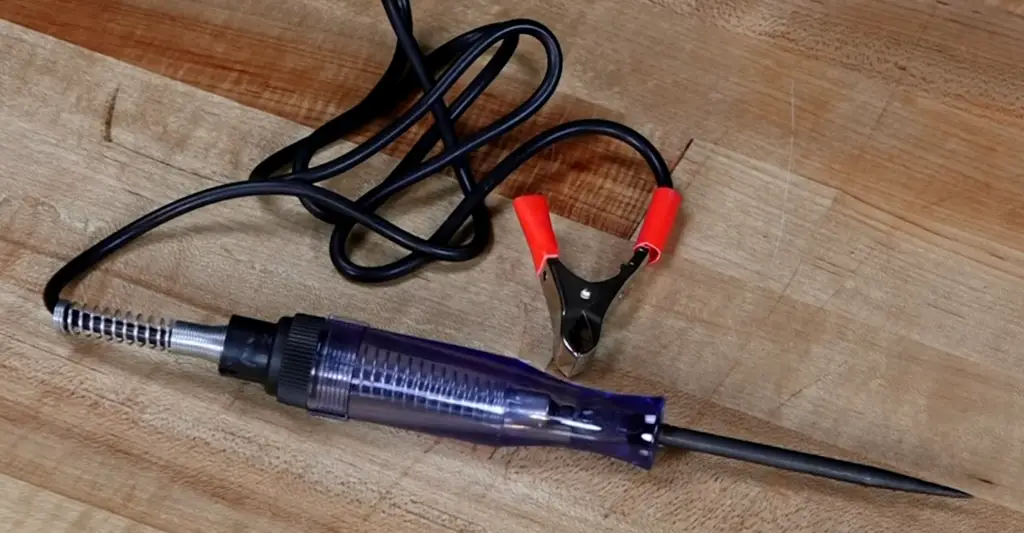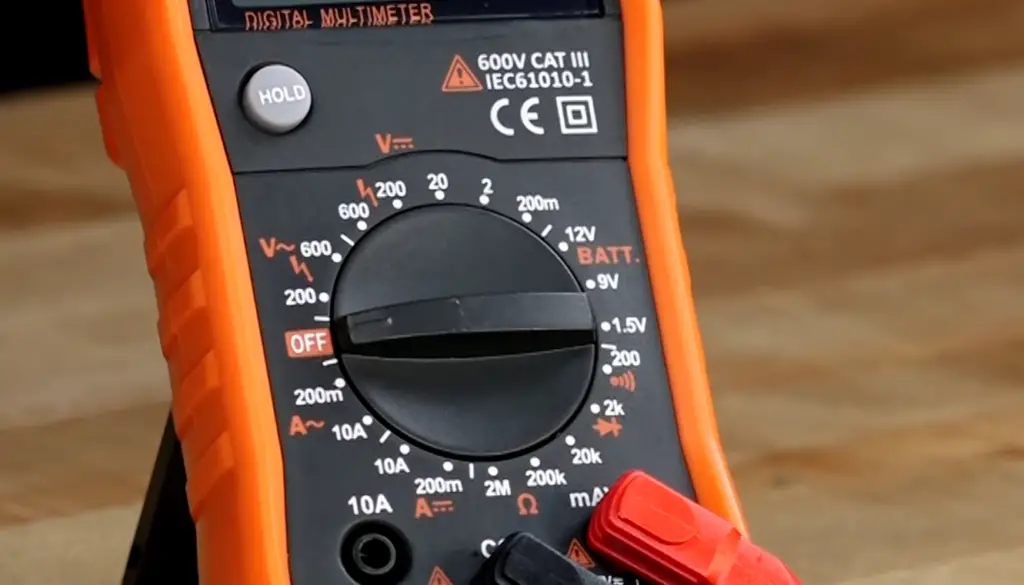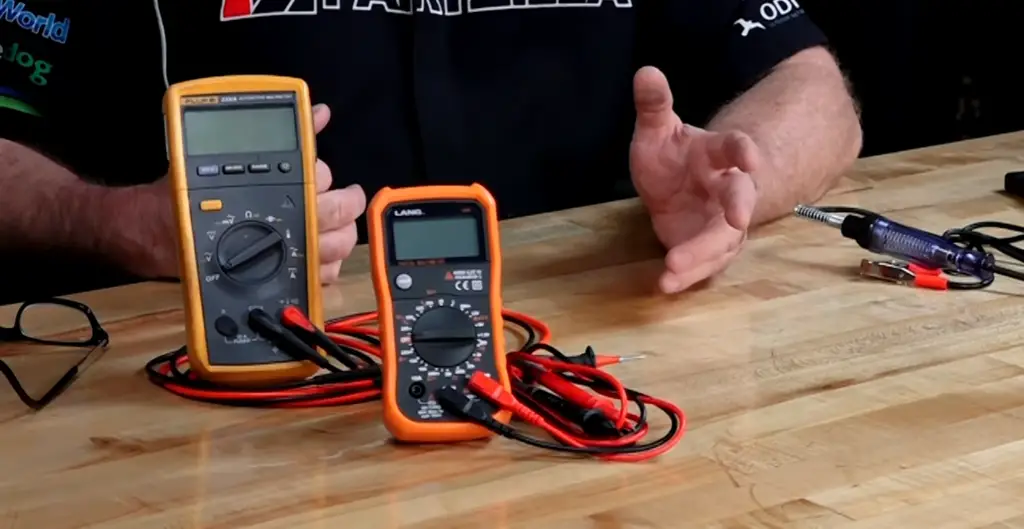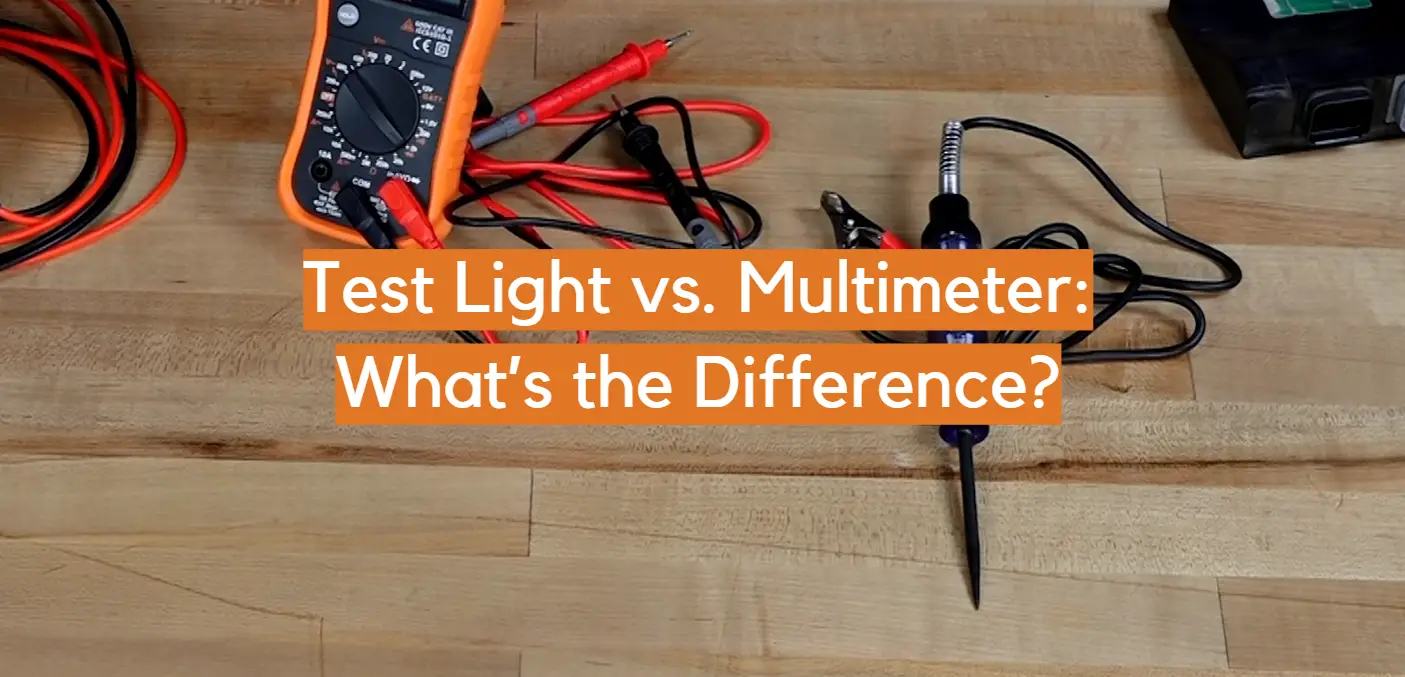When it comes to electrical work, you have a few different options for testing circuits and wiring: a test light, a multimeter, or an oscilloscope. Each tool has its own strengths and weaknesses, and it can be difficult to decide which one to use for a given job.
In this article, we will compare and contrast test lights and multimeters, so that you can make the best decision for your needs.
Test Light vs. Multimeter
It has a lightbulb and two metal clips – one red and one black. When you clip the two clips onto a battery, the lightbulb will light up. If you clip it onto two points in a circuit, it will light up if there is current present.

It has different settings for each measurement. Multimeters are very versatile—they can be used to measure current, voltage, and resistance in both AC and DC circuits. [1]
Test Light Pros and Cons
The main advantage of a test light is that it’s simple to use and very affordable. It can be a great tool for testing basic circuits without having to invest in a more expensive device.
The downside is that it can only tell you if there is a current present or not, so you won’t be able to get any quantitative measurements with it.
Check Battery Voltage with a Test Light
A test light can be used to see if a battery has power. To do this, clip the red metal clip to one terminal on the battery. Touch the black metal clip to another terminal. If there is power in the battery, the lightbulb will light up. This can be a quick way to tell if a battery is dead or not. [1]
Check Circuit Voltage with a Multimeter
A multimeter is a device that can be used to measure the voltage in a circuit. To do this, set the multimeter to “Voltage” mode and then clip the leads onto two points in the circuit.
The multimeter will display the voltage that is present between the two points. This can be helpful when trying to fix electrical problems or checking the voltage output of a device.
Check For Grounds with a Test Light
Grounding is an important safety feature in electrical circuits. It can be tested using a test light. To do this, clip the red metal clip to one terminal on the battery.
Touch the black metal clip to a ground point in the circuit. If there is current flowing to the ground point, the lightbulb will light up.

Multimeter Pros and Cons
Multimeters are very precise tools that can measure current, voltage, and resistance. This makes them perfect for more complex tasks such as troubleshooting electrical problems or analysing circuits.
However, they can be more expensive than test lights and may require more expertise to use correctly.
Test Battery Voltage with a Multimeter
A multimeter can be used to test the battery voltage. Set the multimeter to “Voltage” mode and clip the leads onto two points on the battery. The multimeter will show you how much voltage is between those two points. This can help if you are trying to test an old or damaged battery.
Test lights and multimeters are both useful tools for testing electrical circuits. Test lights are a great way to see if a circuit has electricity.
Multimeters can give you more information about how much electricity is in the circuit, as well as the voltage and resistance. Make sure to consider your needs before making a decision on which tool is best for you.
The Main Differences
The main difference between a test light and multimeter is that a test light can only tell you if there is power or not, while a multimeter can measure voltage, current, and resistance.
A multimeter is also more versatile and can measure both AC and DC circuits.
Test lights are generally cheaper and simpler to use, while multimeters provide more detailed information.

Knowing the differences between a test light and multimeter can help you make an informed decision about which one is best for your needs. [1]
Which is Better: a Test Light or Multimeter?
Whether you should use a test light or multimeter depends on what you need it for. Test lights are good for quickly checking if a circuit has electricity and can also be used to check grounds. Multimeters offer more detailed measurements and can be used to measure current, voltage, and resistance.
Consider your needs before making a decision on which tool is best for you. In any case, make sure to follow all safety instructions and read the instructions carefully before using either tool.
Test lights and multimeters are both useful tools for diagnosing electrical problems. However, it is important to choose the right tool for the job, as using the wrong one can lead to incorrect readings or even injury.
Whichever tool you choose, be sure to read all safety instructions and follow them carefully before use. With a little knowledge and the right tool, you can easily diagnose electrical problems in your home or car.

Test Light vs. Multimeter: A Comparison of Key Indicators
In this comparison table, we take a closer look at the key indicators of these two tools to help you choose the right one for your needs.
| Indicator | Test Light | Multimeter |
|---|---|---|
| Measurement Types | Tests for voltage presence and continuity | Tests for voltage, current, resistance, and continuity |
| Accuracy | Less accurate | More accurate |
| Display | Visual indicator (light or LED) | Digital or analog display |
| Price | Less expensive | More expensive |
| Usage | Simpler and faster for basic testing | More versatile and suitable for advanced testing |
FAQ
Can I use my multimeter as a test light?
Yes, you can use a multimeter as a test light by setting it to “Voltage” mode. This will allow you to see if there is electricity in the circuit by clipping the leads onto two points on the battery and seeing if voltage is present.
What are some safety tips for using test lights and multimeters?
When using test lights or multimeters, it is important to read all safety instructions and follow them carefully. Make sure you are wearing proper protective gear such as rubber gloves and safety glasses.
Additionally, make sure to unplug any device before attempting to take measurements or perform repairs. Finally, if you are unsure of what you are doing, it is best to seek professional help.
Can I use a test light to measure voltage?
No, a test light cannot be used to measure voltage. It can only tell you whether there is electricity in the circuit or not. To measure voltage, you will need to use a multimeter.
Which is better: a test light or multimeter?
It depends on what you need it for. Test lights are good for quickly checking if a circuit has electricity.
Multimeters offer more detailed measurements and can be used to measure current, voltage, and resistance. Consider your needs before making a decision on which tool is best for you.
Do I need a test light if I have a multimeter?
No, you don’t need a test light if you have a multimeter. Multimeters can be used to measure voltage, current, and resistance. But if you are only testing for the presence of electricity in a circuit, it may be simpler to use a test light.
Test lights and multimeters are both useful tools for diagnosing electrical problems. Knowing the differences between the two can help you make an informed decision about which one is best for your needs.
Regardless of which tool you choose, the key is to understand your needs and make sure to get the right one for the job. With a little knowledge and the right tool, you can easily diagnose electrical problems in your home or car.
Are multimeter and tester the same?
No, a multimeter and tester are not the same. A multimeter is a device that can measure voltage, current, and resistance. This tool is often used for diagnosing electrical problems.
A tester, on the other hand, is typically a device designed to test certain components or systems such as automotive batteries or radio antennas. Multimeters and testers have different uses, so it is important to make sure you are using the right tool for the job.
What is an ammeter?
An ammeter is a device that measures the electric current in amperes. It is often used with multimeters to measure how much electricity is flowing through a circuit.
Ammeters are typically connected in series with the circuit so that they do not interfere with or change the flow of electricity. By measuring the current flow, it can help diagnose problems with electrical systems.
What does a test light do?
A test light is a device that is used to find out if there is electricity in a certain area. You use it by attaching one end of the test light to the ground and the other end to the wire that you are testing.
If there is electricity in that area, then the light on the tester will turn on. Test lights are often used to see if an electrical system is working or not without having to use a multimeter.
Test lights can be used to check whether a fuse is blown, a switch is on, or other components in a circuit are working. They can be used on both DC (direct current) and AC (alternating current) circuits. However, they cannot measure voltage or current, so a multimeter is more suitable for those functions.
Can I use a multimeter as a circuit tester?
Yes, a multimeter can be used as a circuit tester. A multimeter is a device that measures voltage, current, and resistance. By using its various functions, you can test different components in an electrical system to determine whether they are working properly or not.
To use a multimeter as a circuit tester, make sure that you have it set to the right setting. For example, if you are testing a DC (direct current) circuit, make sure that your multimeter is set to measure DC voltage. When measuring AC (alternating current), be sure that it is set to measure AC voltage.
Although a multimeter can be used to measure voltage and current, it is not as good as a test light for testing circuits.
A multimeter cannot detect the presence of voltage and current, so it is best used for measuring those values rather than testing them.
Useful Video: Test Light vs. Multimeter
Conclusion
So, what’s the big difference between a test light and a multimeter? In short, a multimeter can do more than just test for continuity. It can also measure voltage, current, and resistance. For most people, a multimeter is the better option because it provides more information.
If you only need to test for continuity, then a test light will work just fine. But if you need to do any other type of testing, then you should invest in a good quality multimeter.
Have you ever used a multimeter to diagnose an electrical problem? What was your experience like?
Preferences
- https://www.partzilla.com/blog/multimeter-vs-test-light-pros-cons














Leave a Reply